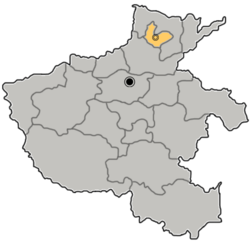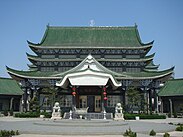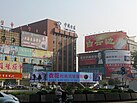Hebi
鹤壁市 Hopi | |
|---|---|
From top, left to right: Temple of the Eight Symbols in Qi County; Pagoda in Xun County; Shancheng District Department Store; View near Hebi East railway station | |
 | |
 Location of Hebi in Henan | |
Location in the North China Plain | |
| Coordinates (Hebi municipal government): 35°44′53″N 114°17′49″E / 35.748°N 114.297°E | |
| Country | People's Republic of China |
| Province | Henan |
| Municipal seat | Qibin District |
| Area | |
| 2,299 km2 (888 sq mi) | |
| • Urban (2018)[1] | 543 km2 (210 sq mi) |
| • Metro | 847.3 km2 (327.1 sq mi) |
| Population (2020 census for total, 2018 otherwise)[2] | |
| 1,565,973 | |
| • Density | 680/km2 (1,800/sq mi) |
| • Urban (2018)[1] | 667,600 |
| • Urban density | 1,200/km2 (3,200/sq mi) |
| • Metro | 574,000 |
| • Metro density | 680/km2 (1,800/sq mi) |
| GDP[3][4] | |
| • Prefecture-level city | CN¥ 77.2 billion US$ 11.6 billion |
| • Per capita | CN¥ 47,940 US$ 7,217 |
| Time zone | UTC+8 (China Standard) |
| Area code | 392 |
| ISO 3166 code | CN-HA-06 |
| Major Nationalities | Han |
| County-level divisions | 5 |
| Township-level divisions | unknown |
| License plate prefixes | 豫F |
| Website | hebi |
Hebi (simplified Chinese: 鹤壁; traditional Chinese: 鶴壁; pinyin: Hèbì [xɤ̂.pî]; postal: Hopi) is a prefecture-level city in northern Henan province, China. Situated in mountainous terrain at the edge of the Shanxi plateau, Hebi is about 25 miles (40 km) south of Anyang, 40 miles (64 km) northeast of Xinxiang and 65 miles (105 km) north of Kaifeng.
As of the 2020 census, its population was 1,565,973 inhabitants and in the 2018 estimate 574,000 lived in the built-up (or metro) area made of Qibin District and Qi County largely conurbated. One can notice that Shancheng District and Heshan District are for the moment, part of another built-up area of 372,600 inhabitants close to Anyang.[2]
Hebi has several coal mines. The city is also home to Hebi New Area, an economic development zone.
- ^ a b Cox, Wendell (2018). Demographia World Urban Areas. 14th Annual Edition (PDF). St. Louis: Demographia. p. 22.
- ^ a b "China: Hénán (Prefectures, Cities, Districts and Counties) - Population Statistics, Charts and Map".
- ^ 河南省统计局、国家统计局河南调查总队 (November 2017). 《河南统计年鉴-2017》. 中国统计出版社. ISBN 978-7-5037-8268-8. Archived from the original on 2018-11-15. Retrieved 2018-12-03.
- ^ "河南统计年鉴—2017". www.ha.stats.gov.cn. Archived from the original on 2018-11-15. Retrieved 2018-12-03.





